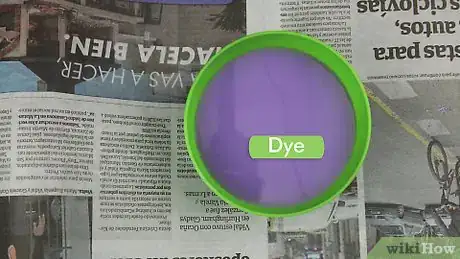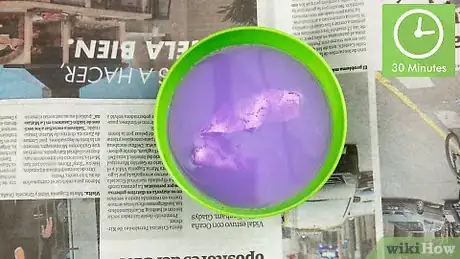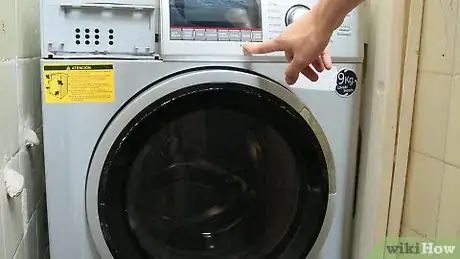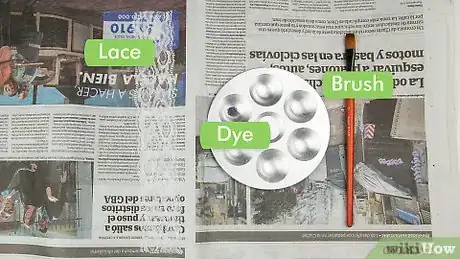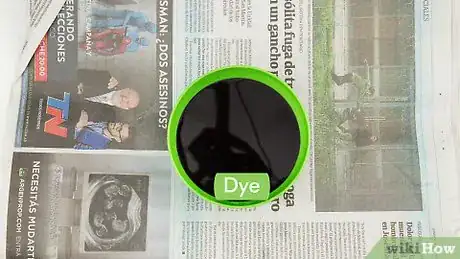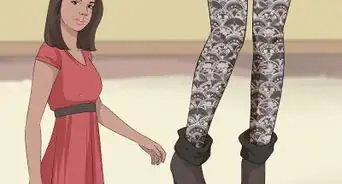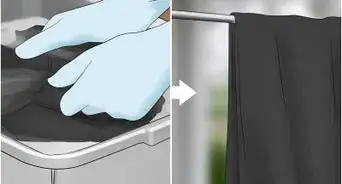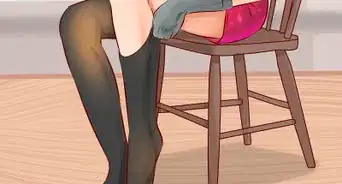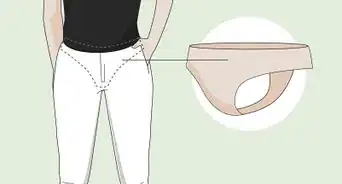This article was co-authored by wikiHow staff writer, Sophia Latorre. Sophia Latorre is a Content Manager on the wikiHow team. Before joining wikiHow, Sophia worked as a technical editor and was published in six International Energy Agency (IEA) Wind Annual Reports. Now, she writes, edits, and reviews articles for the wikiHow Content Team, working to make the content as helpful as possible for readers worldwide. Sophia holds a BA in English from Colorado State University.
The wikiHow Video Team also followed the article's instructions and verified that they work.
This article has been viewed 87,063 times.
Learn more...
If you have a piece of lace that you’d like to be a different color, whether it’s a ribbon or a dress, you can dye it. Lace is very easy to dye as long as it is made of natural fibers. Lace absorbs dye quickly, so you need to apply the dye carefully and check the color often. You can dye lace in whole pieces or you can use dye to color the details individually.
Steps
Dying Whole Pieces
-
1Prepare the dye. The amount of dye you need will depend on how much lace you want to dye. If you have 1 lb (450 g) of lace, you will need one package of powder dye or 1/2 bottle of liquid dye, as well as 3 gallons (12 L) of hot water.[1] Simmer the necessary amount of water in a saucepan and transfer the hot water into a large bucket. Add powder or liquid dye and stir until evenly dispersed.
- If working with powdered dye, dissolve it in 2 cups (500 ml) hot water first before adding it to the large bucket of water.
- The ideal water temperature for your dye bath is 140 degrees Fahrenheit (60 degrees Celsius).
- Make sure that you add the dye to the water before adding the lace. If you add the lace first, you may cause spotting to occur.
-
2Dunk the lace in the dye. Place your lace into the bucket of diluted dye. Make sure that it is completely submerged. You might want to use a wooden or plastic mixing spoon to help keep the lace submerged. You could also use your hands as long as you have thick rubber gloves on.[2]
- It is highly recommended that you wear rubber gloves, a smock or apron, and clothes that you do not mind staining while working with dye.
Advertisement -
3Add salt or vinegar. Use salt if your lace contains cotton, rayon, ramie, or linen. Use vinegar if your lace contains nylon, silk, or wool. After 5 minutes of letting your lace soak, add 1 cup (250 ml) salt to the dye bath or 1 cup (250 ml) white vinegar. Doing so will help intensify and set the color.[3]
-
4Let it sit for up to 30 minutes. For the strongest, richest hue, dye the lace for 30 minutes, stirring slowly and gently throughout the process. If you want a more subtle effect, only keep the lace in for 8 to 10 minutes. Lace absorbs dye quickly and does not need to sit in a dye bath for very long.[4]
- Stirring the lace is highly recommended since doing so helps the fabric dye more evenly.
-
5Rinse the lace with water. Remove the dyed lace from the dye bath and rinse it under warm water for a couple of minutes. Afterward, rinse it under cool running water until the water runs clear.[5]
- Warm water rinses off the surface dye better, but cool water is recommended after you get this surface dye off since it discourages the color from bleeding out.
-
6Wash and dry the lace. Hand or machine wash the lace under a gentle cycle. Wash the lace by itself, with like colors, or with an old towel to prevent the dye from bleeding onto your nice clothes or linens. Use mild detergent and warm water for the cleaning part of the cycle, but use cool water for the rinse cycle. Hang the lace up to dry.[6]
- Note that the lace will be a slightly lighter shade when it dries.
Painting with Dye
-
1Prepare your workspace. For this method, you will need to lay your lace out on a flat surface and paint the lace with dye by hand. As a result, this working space needs to be protected. Spread a plastic bag, tablecloth, or dropcloth on the workspace.[7]
-
2Prepare the dye. Squeeze one to two drops of each dye into a separate compartment of a plastic paint palette, divided plate, or similar container. Dilute each color with 10 drops of warm water from a clean eye dropper.[8]
- The dye color is very concentrated, so you will need to dilute it with water. Do not paint the lace directly with undiluted dye.
- If you want a stronger dye color, you can add another drop or two of dye. Similarly, you can create pastel colors by adding 5 to 10 more drops of water.
-
3Soak the lace in water for a more even color. Soaking the lace in water will help the material absorb, spread, and blend the dye. Soak the lace in a bowl of warm water for a few minutes. Roll the lace in a towel and squeeze out the excess water until the lace is just barely damp.[9]
- Alternatively, you could also spray the lace with water from a fine-mist spray bottle to dampen it instead of soaking it first.
- If you want more distinct colors, however, you should keep the lace dry.
-
4Paint the lace with a paintbrush dipped in dye. Dip the tip of a fine-tip paintbrush into your first dye color, and lightly paint the desired section of lace with that dye color, using a very gentle touch. Use the tip of the brush to paint the fine details. If you need to cover more material, you can use the entire brush head.[10]
- Thoroughly rinse and dry the brush before loading it with a new dye color.
- If you are working with wet lace, mist the lace with water periodically to keep it damp.
-
5Apply multiple layers of dye as needed. Use a gentle touch when applying the dye. After your initial application, go back over those same areas again with another layer of dye, repeating this until you achieve the desired shade. Lace absorbs dye very quickly, so if you get too impatient and use too much at once, you may end up making the lace too dark.[11]
- Do not dampen the lace again when adding multiple layers of dye.
- If the lace becomes too dark, you can remove the excess dye by blotting it with a paper towel. This works better if you are using a wet application instead of a dry application, though.
-
6Blow dry the lace. You can dry the lace by air, but doing so may result in a spotty appearance. You will likely have more success if you use a hairdryer on a warm setting, at high speed, to dry the lace quickly. Using a hairdryer reduces the spread of the color that comes about when the liquid component of the dye evaporates.[12]
-
7Set the color using an iron. Turn the lace over so that the back side faces up. Iron it on a wool setting with a standard iron for roughly two minutes. The color should be well set afterward.[13]
- Note that setting the color with an iron also helps soften the lace.
Creating an Ombre Look
-
1Prepare a small batch of dye. The amount of dye you need will depend on the size of the garment you are dying. Generally, 0.5 cups (120 mL) of liquid dye or 1 box of powdered dye is sufficient for a 1-lb (450-g) garment. Combine the dye with the appropriate amount of water (as directed on the package) in a glass bowl or plastic bucket. Stir until the dye is dissolved.[14]
- You can add 1 Tbsp (15 ml) of salt to the mixture to help make the final color more vibrant. It can also help the dye to set.
- The ideal water temperature should be about 140 degrees Fahrenheit (60 degrees Celsius).
-
2Soak the lace in hot water. Dip the lace in hot water and gently wring it out with your hands. It should be damp when you get ready to work with it, as damp lace will absorb the dye better than dry lace.[15]
- Soaking the lace is essential if you want to create an ombre effect since the shades of dye will need to blend together in a gradient. If you keep the lace dry, on the other hand, you will not be able to achieve this gradient effect.
-
3Dunk the bottom third of the lace in the dye. Lower roughly one-third of the lace into the dye bath and leave it in for 10 minutes. This will be the darkest part of the ombre pattern. Agitate the dye to produce a more even color by continually moving the lace from side to side. Do not move it up and down, though.[16]
- Wear thick rubber or plastic gloves to prevent the dye from getting on your skin.
- Alternatively, you could use a coffee stirrer or disposable plastic spoon to agitate the dye.
- You can wrap the top third of the lace around a dowel bar to help keep it steady and even, if you like.
-
4Soak the next third for 5 minutes. To create the next darkest color, lower two-thirds of the lace into the dye bath. Let it sit for 5 minutes, and continue agitating the lace in the same manner to produce an even color.[17]
-
5Submerge the final portion of lace in the dye for 1 minute. Dunk the rest of the lace into the dye bath so that the entire piece is submerged. Leave it there for 1 minute while agitating the dye. This will make the final portion of the garment lighter than the rest.[18]
- Alternatively, you can keep this last portion the original color and skip submerging it in the dye.
-
6Rinse the lace immediately with lukewarm water. Remove the lace from the dye bath and immediately rinse it under lukewarm running water until the water runs clear.[19]
-
7Repeat, if desired. If the ombre effect isn’t as strong as you’d like it to be, you can repeat the process. Dunk the bottom one-third to one-half of the lace back in the dye and allow it to sit for a few minutes. Check the lace often to see if it has reached the desired shade.[20]
-
8Rinse and dry the lace. Rinse the lace in lukewarm water until the water comes out clear. Let the lace air-dry or speed up the process by drying the lace with a hairdryer.[21]
Community Q&A
Did you know you can get answers researched by wikiHow Staff?
Unlock staff-researched answers by supporting wikiHow
-
QuestionCan I dye old lace?
 wikiHow Staff EditorThis answer was written by one of our trained team of researchers who validated it for accuracy and comprehensiveness.
wikiHow Staff EditorThis answer was written by one of our trained team of researchers who validated it for accuracy and comprehensiveness.
Staff Answer wikiHow Staff EditorStaff AnswerIf the old lace is strong, not fraying and in excellent condition, then it may be okay to dye it; indeed old lace is often yellowed or discolored and this can be a good way to improve its appearance. If it shows any signs of aging and fragility though, it would be best not to dye it. Also take into consideration the value of the lace; dyeing may reduce its value as part of a collection or for vintage sales.
wikiHow Staff EditorStaff AnswerIf the old lace is strong, not fraying and in excellent condition, then it may be okay to dye it; indeed old lace is often yellowed or discolored and this can be a good way to improve its appearance. If it shows any signs of aging and fragility though, it would be best not to dye it. Also take into consideration the value of the lace; dyeing may reduce its value as part of a collection or for vintage sales. -
QuestionCan I dye lace with tea?
 wikiHow Staff EditorThis answer was written by one of our trained team of researchers who validated it for accuracy and comprehensiveness.
wikiHow Staff EditorThis answer was written by one of our trained team of researchers who validated it for accuracy and comprehensiveness.
Staff Answer wikiHow Staff EditorStaff AnswerYes, you can dye some types of lace using tea––cotton and silk laces, and many synthetic laces can be dyed with tea. For help with dyeing fabric using tea, see How to Dye Fabric with Tea.
wikiHow Staff EditorStaff AnswerYes, you can dye some types of lace using tea––cotton and silk laces, and many synthetic laces can be dyed with tea. For help with dyeing fabric using tea, see How to Dye Fabric with Tea. -
QuestionHow can you tell what lace is made of?
 Community AnswerRead the tag on the garment carefully to determine what the lace is made of. Dye works best on natural, rather than synthetic, fabrics.
Community AnswerRead the tag on the garment carefully to determine what the lace is made of. Dye works best on natural, rather than synthetic, fabrics.
Things You'll Need
Dying Whole Pieces
- Large bucket
- Fabric dye (powder or liquid)
- Water
- Saucepan
- Plastic bucket
- Mixing spoon
- Lace
- Plastic or rubber gloves
- Salt or vinegar
Painting with Dye
- Fabric dye (liquid)
- Lace
- Fine-tip paintbrush
- Painting palette
- Fine-mist spray bottle
- Water
- Eye dropper
- Plastic dropcloth
- Plastic or rubber gloves
- Clean towel or rag
- Paper towels
Creating an Ombre Look
- Fabric dye (liquid or powder)
- Lace
- Glass bowl or plastic bucket
- Water
- Salt
- Dowel rod
- Plastic spoon
- Plastic or rubber gloves
References
- ↑ http://www.ritdye.com/dyeing-techniques/tips-success
- ↑ https://www.ritdye.com/techniques/the-basics/sink-or-bucket-technique/
- ↑ https://www.ritdye.com/techniques/the-basics/sink-or-bucket-technique/
- ↑ http://www.elleapparelblog.com/2012/07/fit-to-be-dyed.html
- ↑ https://www.ritdye.com/techniques/the-basics/sink-or-bucket-technique/
- ↑ https://www.ritdye.com/techniques/the-basics/sink-or-bucket-technique/
- ↑ https://www.threadsmagazine.com/2012/05/02/how-to-make-painted-lace
- ↑ https://www.threadsmagazine.com/2012/05/02/how-to-make-painted-lace
- ↑ https://www.threadsmagazine.com/2012/05/02/how-to-make-painted-lace
- ↑ https://www.threadsmagazine.com/2012/05/02/how-to-make-painted-lace
- ↑ https://www.threadsmagazine.com/2012/05/02/how-to-make-painted-lace
- ↑ https://www.threadsmagazine.com/2012/05/02/how-to-make-painted-lace
- ↑ https://www.threadsmagazine.com/2012/05/02/how-to-make-painted-lace
- ↑ https://www.ritdye.com/techniques/creative-techniques/ombre/
- ↑ https://www.ritdye.com/techniques/creative-techniques/ombre/
- ↑ https://www.ritdye.com/techniques/creative-techniques/ombre/
- ↑ https://www.ritdye.com/techniques/creative-techniques/ombre/
- ↑ https://www.ritdye.com/techniques/creative-techniques/ombre/
- ↑ https://www.ritdye.com/techniques/creative-techniques/ombre/
- ↑ https://www.ritdye.com/techniques/creative-techniques/ombre/
- ↑ https://www.ritdye.com/techniques/creative-techniques/ombre/
